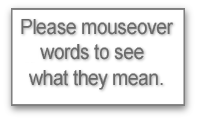Translocation of great crested newts
17-September-2009
Transcript of great crested newt translocation
"Ring-fence and pitfall traps: What that means is that you have a breeding pond and every year during February-March through to June the adults that are choosing to breed that season will migrate into the pond from a terrestrial habitat.
"So what you do is dig in a fence around the breeding pond and put buckets flush into the ground on either side of the nets, open the lids up and then, as the newts walk towards the ponds they meet the fence, turn left or right and fall into a bucket."
How big are these buckets?
"About so."
Just wee buckets with water in them?
"No water. You just put terrestrial refuse, things like moss or leaf litter. It doesn't hurt them. They're fine. They fall in and you have a slat in the bucket to protect them from aerial predators - any birds that are trying to eat them. Then you also have a mammal ladder, which is a very technical term for a stick, which you put in in case shrews or voles fall in and they can run out again.
"I had a classic with one pitfall trap I was doing. It had a frog, with a toad on the frog, and a vole on top of the toad - all sitting in the bucket waiting to get out. The vole could have got out because of the mammal ladder ..."
"The studies I was doing were different because I was looking to see what was about and whereabouts they were moving. So I just released them and let them on their way. But when HEL were capturing them to translocate them across to the nature reserve. So they would use pitfall traps. They also used funnel traps - two-litre plastic bottles designed to be put in water. The adult newts can swim into the bottles but can't get back out. So they'd use them to capture more adults.
"They would also net the pond for the larvae and translocate them across in buckets of water.Sub-adults would also walk back to the pond so they could be captured in that way. By doing the translocation over a three year period you're giving all the metamorphs the chance to mature into adults that would then come back into the pond to breed - you're capturing as much of the population as possible.
"They also move across the eggs by a variety of means. Great crested newt females lay between 180 to 220 eggs in a season. Unlike frogs, which lay in an explosive breeding episode - frog spawn - great crested newts actually lay individual eggs, which they wrap in leaves.
"So one way to identify if there's a great crested newt population in a pond is to look at the vegetation. You're looking for folded-up, concertina-like leaves. So for example a blade of grass you'd see as a series of zig-zags where it's been folded over. Or willowherb - which has a small leaf that sort of shape - would be pinched shut. The newts use a sticky substance on the egg to keep the leaf shut.
"So they can either move vegetation, which they can see has had eggs laid on it, into the new pond. Or they can use strips of bin-liner, weighted down, which the newts will use for laying their eggs on.
"Then you just pick up the whole strips of bin-bags and move them across so the new eggs are actually hatched into the new ponds."
More help with words
| amphibians | conserve | immature | juvenile | larva | larval |
